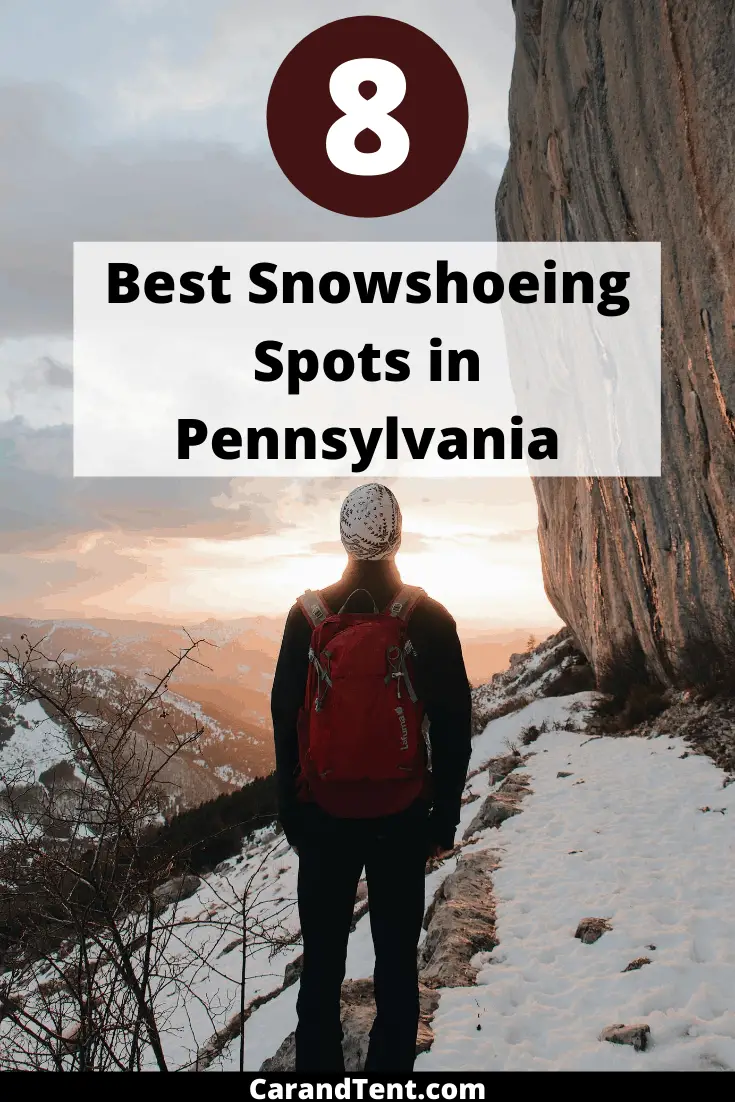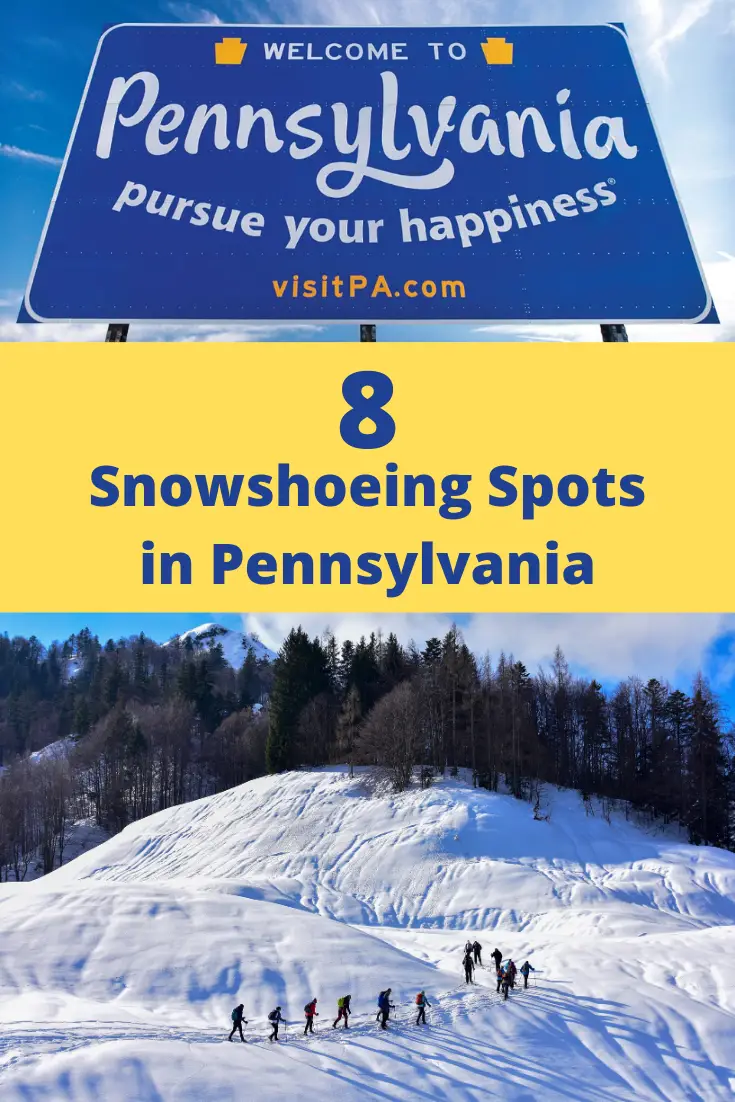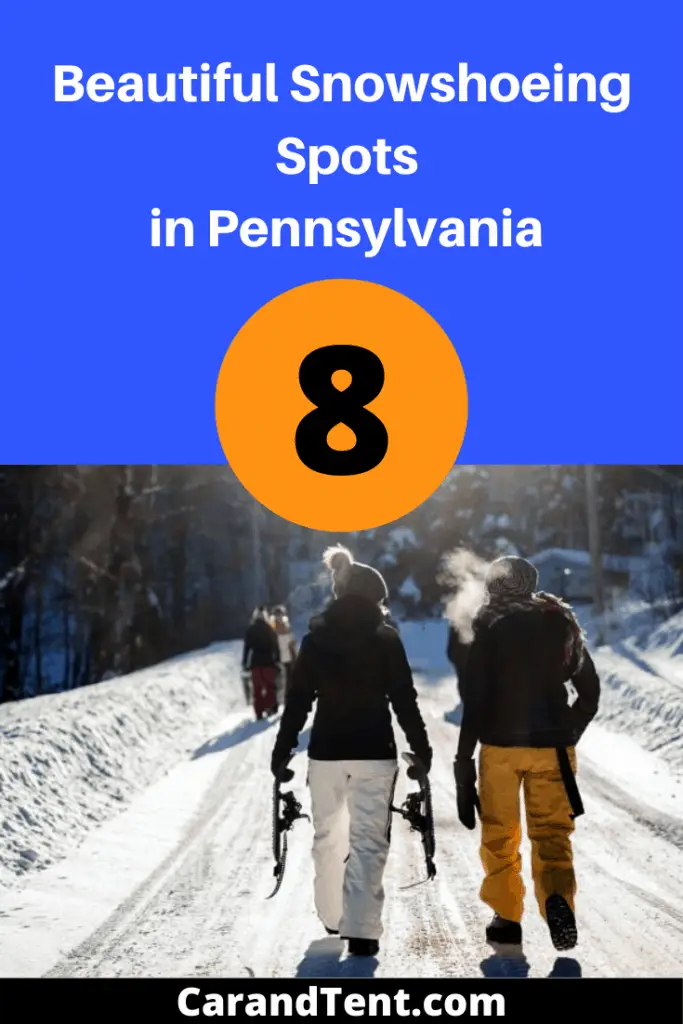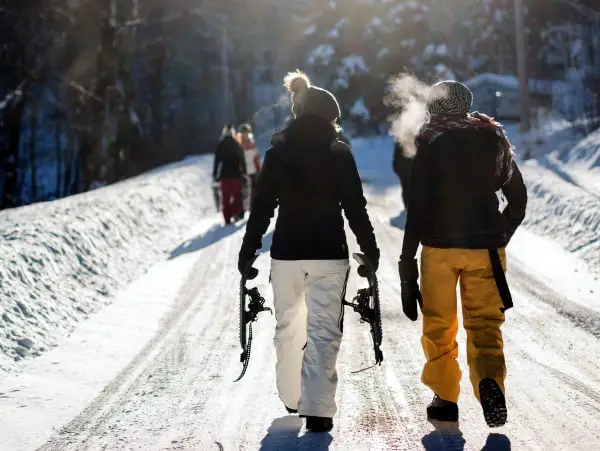
Looking to go snowshoeing in Pennsylvania this winter? Here are some of my favorite snowshoeing spots in Pennsylvania.
Table of Contents
Places to Snowshoe in Northeastern Pennsylvania
With its high elevations, vast wilderness areas, and cooler temperatures, northeastern Pennsylvania is a great place to go snowshoeing. I could probably list places to snowshoe in northeastern PA all day but I’ll keep it at two. Here are my top picks.
Promised Land State Park
Promised Land State Park is open year-round from sunrise to sunset and you can even rent heated rustic cabins with private bathrooms there. There are about 50 miles of hiking trails to snowshoe through and two lakes to snowshoe around. The trails at the park are well-marked and the park is well-staffed so you’ll have people close by should you run into trouble. You’ll even find that the park has a few small but interesting waterfalls to snowshoe by.
There are also snowmobile trails as well as xc skiing trails so you won’t be restricted to just snowshoeing. Not only this, but the dual lakes also provide an opportunity for ice fishing.
One of the best features of this park is the fact that it’s covered in snow throughout most of the winter. While the average state area only gets 28 inches of snowfall a year, this park gets an average of 63 inches a year. Also, because the park sits at over 1,800 feet in elevation, the snow tends to stick around until late spring. Of course, the downside to this is that the weather gets cold up there. The average low in January is about 14 degrees, so make sure you dress warmly before heading out.
Tuscarora State Park
Tuscarora State Park is further southeast than Promised Land State Park so it’s a bit more convenient for people heading up from the southern part of the state where we don’t always get enough snow to go snowshoeing each year. It isn’t the biggest state park but it still offers about 8 miles of trails. The trails are also very hilly and difficult so you’ll spend more than enough hours trying to snowshoe through them.
You’ll also find beautiful views of the lake which can be ice fished on as well. Just be careful if you decide to snowshoe across the lake as the thickness is not monitored.
Before heading over to Tuscarora State Park, make sure they’ve gotten some snow. This area of the state only gets about 41 inches of snow each year but once the snow falls it usually sticks around through the winter as the temperatures are quite cold.
Unfortunately, if you’re planning on spending the weekend snowshoeing in Tuscarora State Park, you’ll have to find alternative lodging. The park does allow camping but it’s seasonal so you’ll be out of luck in the winter. If you’re coming from the south, I’d recommend you check out Jim Thorpe as there are plenty of places to stay and restaurants to visit there. It also has its own hiking trails nearby that you could snowshoe on as well.
Places to Snowshoe in Northwestern Pennsylvania
The northwestern part of the state also offers many opportunities for snowshoeing. Winter temperatures in this area of the state are low and elevations are high. Also, the great lakes are known to bring additional snow to the area.
In fact, places like Erie Pennsylvania can get over 100 inches of snow each year. Two years ago, the city got 58.5 inches in just two days! If five feet of snow isn’t deep enough for you to go snowshoeing in, I don’t know what is. If you happen to be in Erie, check out the Asbury Woods for snowshoeing trails and even nearby snowshoe rentals. Otherwise, see my top two recommendations below.
The Allegheny National Forest
The Allegheny National Forest is one of the best places to go snowshoeing in the state. It has elevations up to 2,300 feet and it’s in the northernmost part of the state so you get plenty of cold weather and snow to work with. There are over 517,000 acres to explore and an immense amount of hiking trails to navigate your way through. These trails can range in size from a half-mile all the way up to 87 miles long, so there’s something for everyone.
If you’re feeling adventurous, you can even go primitive camping year-round. Before camping in some areas of the forest, you must notify the rangers and in others, you don’t have to. This being said, regardless of where you decide to camp, it’s a good idea to contact the rangers to let them know where you’ll be before heading out. This is especially true when there’s a lot of snow on the ground as rescue crews might have a harder time finding you.
The Advantages of Snowshoeing in The Allegheny National Forest
- There are a lot of miles of trails to snowshoe on.
- You’ll have beautiful views of reservoirs, streams, and mountains.
- The traffic in and out of the area is sparse.
- You can primitive camp for free.
- There are many local campgrounds to choose from.
- The towns surrounding the forest are fun to stop in and explore.
A person could go snowshoeing in the Alleghenies all winter long and never run out of new areas to explore. Between the hilly terrain, great overlooks, and the wide abundance of streams, there’s always a nice view to take in just around the next corner.
On top of all of this, the traffic in and around the area is almost non-existent in the winter. If you’re looking to stay longer, primitive camping is always free and there are usually a few campgrounds to choose from for a less primitive stay. If you do finally get tired of snowshoeing, head into one of the many small towns in the area and you’re sure to have a lot of fun.
The Disadvantages of Snowshoeing in The Allegheny National Forest
- Many of the forest roads may be closed when you get there.
- You won’t see a lot of old-growth trees.
- The forest is ATV and snowmobile friendly.
- Internet and phone reception can be limited.
While there are a lot of forest roads to drive in and out of, you may find the gates closed on many of them. This is especially true in the winter. Also, the forest is actively harvested for timber so you won’t find a whole lot of old-growth trees.
Another drawback to the area is that it’s ATV and snowmobile friendly. While this might be great for people looking to do some snowmobiling, it can ruin things for snowshoers who’re just looking for some peace and quiet in the outdoors.
With such a modern forest, you might think that you’d be able to get cell phone reception and a solid connection to the Internet. Unfortunately, you’d be wrong in thinking that way. The forest might not be old, but it’s still dense enough to block cell towers and you may find yourself in the woods without any reception.
Jennings Environmental Education Center
The Jennings Environmental Education Center offers up 300 acres of forests and prairie to explore. It also has about 5 miles of trails. These trails consist mostly of small and easy to hike loops making them great for beginner snowshoers who don’t want to venture too far their first time out.
For those of you who don’t feel 5 miles of trails are enough, keep in mind that the national scenic trail goes through some of these trails so you could take that and head out even further. Of course, I wouldn’t recommend this as a starting point for traversing the 3,200 miles that the national scenic trail consists of.
The Advantages of Snowshoeing At Jennings Environmental Education Center
- The center is open every day of the year.
- Motorized vehicles are not allowed.
- The center will lend you snowshoes.
- You can cross-country ski.
- There are many state parks nearby.
The center is located just off of a main road and it’s open all year so you won’t have any trouble getting in and out of it. Also, there are office hours Monday through Friday as well as some weekend office hours as well. This means you’ll have facilities to use and a place to go into should you get too cold while out on the trails.
Motorized vehicles are banned so you won’t have to worry about getting run over by an ATV or snowmobile. In fact, bikes aren’t even allowed on the trails here so it’s generally a really safe place to snowshoe.
On top of all of this, the center will actually lend out snowshoes. If you’re new to snowshoeing and just want to see if you like it, this is the perfect opportunity to try it out without having to spend any money. They don’t lend out cross country skis yet, but you can bring your own and enjoy a day of cross country skiing and snowshoeing throughout the center’s nearby trails.
For those of you who are coming from out of town, there are a lot of nearby state parks. Some of these state parks have a lot of hiking trails themselves and many of them allow camping.
The Disadvantages of Snowshoeing At Jennings Environmental Education Center
- There aren’t a lot of trails.
- You can’t stay there overnight.
There aren’t too many downsides to snowshoeing at the Jennings Environmental Education Center. The only ones that come to mind for me are that there aren’t a lot of trails to explore. However, if you’ve ever been snowshoeing, you know that you don’t need many miles of trails to get a great workout. Snowshoeing is tough and five miles of trails should be enough for a day of fun.
Another drawback could be that you can’t camp overnight at this site. This really isn’t a big deal though because you can camp nearby in one of the many state parks this region has to offer.
Places to Snowshoe in Southeastern Pennsylvania
Snowshoeing in southeastern Pennsylvania is a bit more difficult than snowshoeing in the northern regions of the state. The reason for this is that you never know how much snow the region will get from year to year.
I grew up in the suburbs of Philadelphia and I remember storms like the blizzard of 1996 which buried us in 31 inches of snow. At the time, I was still in grade school and we ended up getting an entire week off from school – I was in heaven! Of course, I also remember years when we didn’t get any snowfall at all.
To fully take advantage of snowshoeing opportunities, you either have to be prepared to drive up north a bit or you have to be prepared to wait for snow and then to move quickly on it after it falls. For instance, I’ve gone snowshoeing in Philadelphia a couple of times, but I had to head out as soon as the snow stopped falling. We tend to get some good storms at the end of winter but they all melt away within a day or two.
Let’s talk about where to go when the snow does fall.
Fairmount Park
Fairmount Park may seem like an odd place to go snowshoeing but it can be a great place to go after a snowstorm. Remember, you only need about 6″ of snow to safely use a pair of snowshoes so if you get a quick 8″ to 12″ storm, you’ll have enough powder on the ground to have fun with.
The key to using Fairmount Park for snowshoeing is to get there quickly. Keep a personal day or vacation day in reserve so that you’ll be able to immediately take advantage of any big overnight snowfalls. This takes the drudgery out of having to commute to work on a snow day and turns it into a day of fun.
The picture below is a picture I took off the bridge near Valley Green Inn. It can easily be accessed by parking at the Wissahickon Valley Park entrance of Fairmount Park.
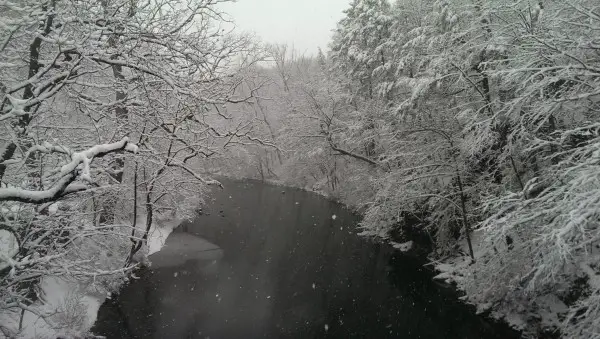
Advantages of Snowshoeing in Fairmount Park
- It’s close to home.
- There are a ton of trails.
- It will likely be empty.
The main advantage of snowshoeing in Fairmount Park is that anyone living within Philadelphia or the Philadelphia suburbs will be close to it. There are many different entrances and many different places to park and most of them are actually plowed pretty quickly.
This park also has many different trails to explore. In fact, you could probably go snowshoeing here for the next 10 years and never get to snowshoe on all of them. The trails are also well traversed and well marked so you won’t have to worry about getting turned around. This makes the trip a lot safer than it might be out in the wilderness areas of the northwestern part of the state.
Another advantage of this area is that even though you’ll be close to civilization, you’ll feel like you aren’t. The same parking lots that are difficult to even walk around in on nice summer days will be completely desolate after a snowstorm. The first time I went snowshoeing there, I was all alone. It ended up being one of the most peaceful experiences I’ve ever had there.
Disadvantages of Snowshoeing in Fairmount Park
- You won’t have many opportunities to snowshoe there.
- Getting through the city can be difficult sometimes.
As I said earlier, you just don’t get much snow in this region. On top of this, the snow that does fall tends to melt quickly. This means that if it snows on a Thursday and you can’t get off from work until Saturday, you’ll probably miss your chance.
On the rare occasion that the city does get a lot of snow, you may find that it becomes overwhelmed by it. This means that the city streets do not get cleared very quickly and you might end up getting stuck while trying to make your way to the park. Throw in the fact that Philly drivers tend to be angry and aggressive and the drive just might not be worth it. My advice would be to check the traffic reports and to wait until well after rush hour is over before heading out.
Ridley Creek State Park
Ridley Creek State Park is another one of those places that can be great to snowshoe in, but again, you’ll have to act quickly. This moderately sized state park has 13 miles of hiking trails that move over and around the creek.
The water and the surrounding areas look really pretty after a snowstorm and you’ll have plenty of picture-taking opportunities while moving through the park. Just keep in mind that the creek probably isn’t going to freeze over completely so you’ll want to avoid trying to snowshoe over it.
Advantages of Snowshoeing in Ridley Creek State Park
- You don’t have to go to the city.
- The park is managed by the state.
- The trails aren’t very difficult.
The primary advantage of snowshoeing in Ridley Creek State Park is that you don’t have to go through the city to get there. People living in the suburbs of the city can save themselves a lot of time, effort, and frustration by heading to Ridley Creek instead of Fairmount Park.
Also, the park is managed by the state. This means you’ll have facilities and even rangers to call on if you run into trouble. Restrooms and trail maps can be found in a few different areas of the park which certainly makes life easier.
The hiking trails at this park aren’t very difficult either. DCNR’s website describes the park’s terrain as “gently rolling” and I’d say that’s a perfectly apt description. This makes this park perfect for people who don’t snowshoe a lot or who don’t want to exhaust themselves doing so.
Disadvantages of Snowshoeing in Ridley Creek State Park
- The park is open to hunters.
- It could get crowded.
- The trails aren’t very challenging.
People could be out hunting deer in the park as you’re snowshoeing through it. This shouldn’t be a problem for you, but it is something to keep in mind. Designated hunting areas are away from the trails but it can’t hurt to wear some bright clothing just in case you end up wandering away from the main trail areas.
Another downside is that Ridley Creek isn’t just great for hiking and snowshoeing. People also use it for hunting, fishing, biking, horse riding, sledding, and XC skiing. In short, you may find that you aren’t the only one there.
Although I’ve already said this once, I think it is important to know that the trails just aren’t very challenging. I like the park but I personally find it to be a bit boring. If you’re an experienced snowshoer, you might end up feeling the same way too.
Places to Snowshoe in Southwestern Pennsylvania
The southwestern section of Pennsylvania has just as many great snowshoeing locations as the northern parts of the state. This is because the mountains here offer great elevations that attract and keep a good amount of snow.
Here are two of the best places to go snowshoeing in Southwestern PA.
Ohiopyle State Park
Ohiopyle State Park is an absolute dream for outdoor lovers. It’s the largest state park in the highest mountains of Pennsylvania. At the park, you’ll find plenty of opportunities to hike, bike, ski, sled, white-water raft, rock climb, hunt, snowmobile, camp, and of course to snowshoe as well.
Advantages of Snowshoeing in Ohiopyle State Park
- The park has absolutely beautiful scenery.
- There is a lot to do.
- Overnight camping options are plentiful.
- It’s close to Pittsburgh
- Offices and visitor centers are open year-round.
- The facilities are clean and well-maintained.
Ohiopyle trails can reach elevations of up to 2,906 feet. As you can imagine, this offers spectacular views of the surrounding areas. These views are even better during the snowshoeing season because you don’t have as much foliage to block your views.
On top of this, the Youghiogheny River gorge passes through part of the 19,052 acres of the park and that provides spectacular winter views as well. Spend an entire week in Ohiopyle state park and you’ll still never get to see all of the waterfalls and great overlooks that the park has to offer.
People coming from out of town will be delighted by the number of camping options available in the area. In fact, you can even rent out cottages with full electricity within the park, so you can spend less time driving to and from there and more time snowshoeing.
If you’d like a more luxury experience, you could try out one of the local resorts or even head over to Pittsburgh. Pittsburgh is less than an hour away from the park and there are many high-end hotels there to choose from.
Another thing I like about Ohiopyle is the facilities. For the most part, the bathrooms are always clean and you rarely have to wait for a shower in the winter. Also, the office and visitor centers are open all year so even if you’re just visiting for the day, you’ll have someplace to go into to get warm.
Disadvantages of Snowshoeing in Ohiopyle State Park
- It can get crowded.
- It can be overwhelming for some.
This state park attracts a lot of people. The DCNR says that millions of people visit the park each year and if you go there on a weekend or during an event, you won’t be surprised by this fact. This can make parking difficult and there may not be an open space to camp when you arrive. However, this typically isn’t as big of a problem in the winter, and you can always book your stay in the campgrounds in advance.
Another drawback for some people might be the fact that the park is so large. There is a lot to do there and this can get overwhelming for some people. This is especially true for people who go there expecting to be able to see it all. If you plan on heading there yourself, keep in mind that you’ll only be able to see a small part of it on any single trip and just make peace with that fact. The park is just too large to be experienced over a weekend or even on a week-long trip.
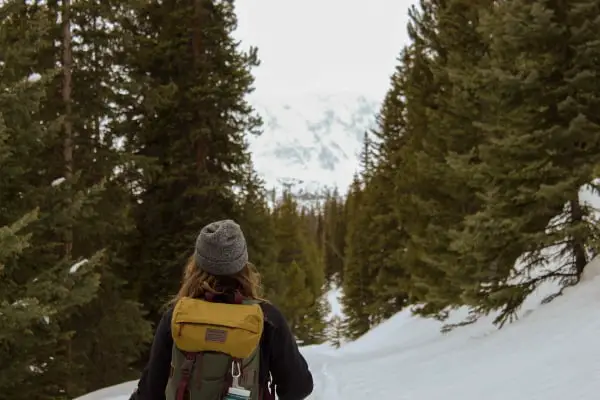
Laurel Ridge State Park
Laurel Ridge State Park is massive. It stretches out over 13,625 acres and lives in four different counties of Pennsylvania. Within this vast wilderness, you’ll find views of both the Youghiogheny River as well as the Conemaugh Gorge.
You’ll also find the Laurel Highlands Hiking Trail which offers up over 70 miles of hiking and snowshoeing fun. This stretch of the trail can be accessed through six different trailheads, so don’t feel like you have to hike the whole trail in just one trip.
Advantages of Snowshoeing in Laurel Ridge State Park
- There is almost always enough snow to snowshoe in the winter.
- Rustic camping is abundant.
- There are great overlooks.
- The trails are very well-marked.
- You’ll find plenty of additional recreational opportunities.
Laurel Ridge State Park can hit elevations of up to 2,759 feet. If you’ve read my quick guide to hiking up a mountain, you know that this means it’s going to be much colder than the flatter areas of the state. Because of this, the trails here are often covered with snow all winter long. On top of this, the mountains offer beautiful overlooks that give you wonderful views of the countryside as well as the city.
You don’t have to limit yourself to just a few hours of snowshoeing and taking in the views either. The Laurel Highlands Hiking Trail allows you to camp along the trail and there are shelters with fireplaces that you can use along the way.
Another advantage of snowshoeing in this state park is the fact that the trails are so well-marked. According to the DCNR, there are yellow blazes every 1,000 feet along the main Laurel Highlands Trail and blue blazes throughout all of the connector trails. This might not seem like a big deal but remember, visibility can be poor when it’s snowing and trails aren’t always quite as easy to see when the ground is covered in snow, so it helps to hike along trails that are well-marked.
For those of you who want to drag along non-snowshoeing friends and family members, they’ll be delighted to know that there are plenty of other things to do within the park. Ice fishing, sledding, skiing, and snowmobiling are all popular winter activities that can be done within the park.
Disadvantages of Snowshoeing in Laurel Ridge State Park
- The trail is windy and cold.
- Water at trailheads is not potable.
One major disadvantage of snowshoeing in the Laurel Ridge State Park is that the main trail will expose you to a lot of wind and cold weather. This feels great in the summer but it can make a cold winter day feel even worse.
Additionally, you won’t find any potable water along the trail. This means you’ll have to bring your own water or make plans to purify the water at the trailheads. Luckily, the ground will be covered with snow so you could potentially boil that down and run it through a backpacking water filter if you had to.
Don’t Feel Left Out
If your favorite snowshoeing spot didn’t appear on this list, don’t feel left out. Pennsylvania is a big state and I wanted to offer up a detailed review on each of the places listed. This necessarily made the number of Pennsylvania snowshoeing spots I could list quite small.
For those of you that already have a place in PA that you love to snowshoe in, keep going there! If you’d like to see what else is out there though, why not take a trip to one of the spots I listed above?

